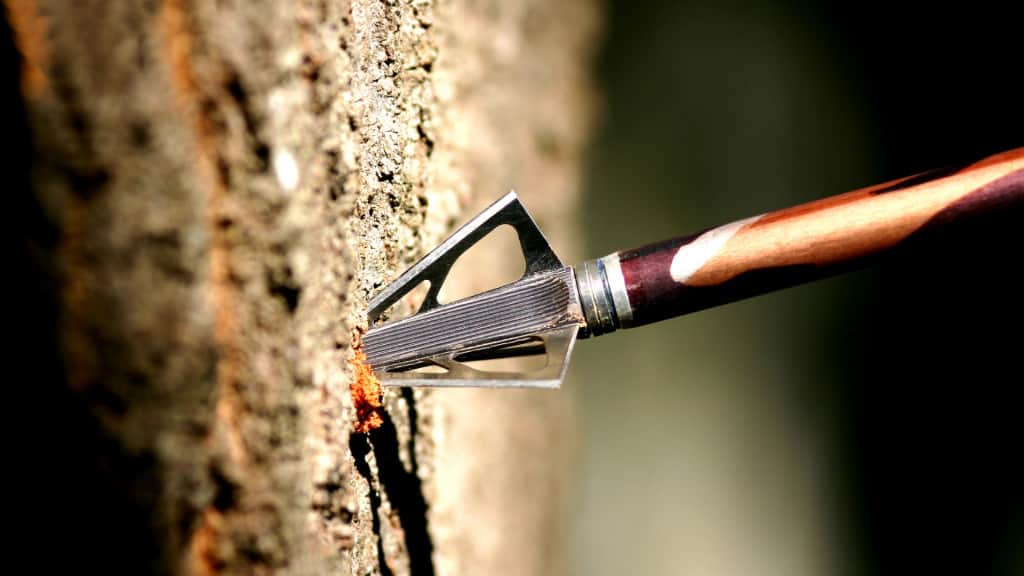Fact checked by Steven Lines, lifelong Hunter, and Outdoorsman .
.
People enjoy debating the different arrow types that they can use in archery. The goal is always accuracy, consistency, arrow penetration, and speed. When an arrow leaves the bow, it is at its maximum velocity, slowing from that point. This is where the weight of the arrow comes in.
The reality is that if you take two arrows that are identical in all of their features, but one is heavier than the other, the heavier arrow will have more kinetic energy from the draw of the bow. It will travel slower, but it can better resist wind and other factors that decrease an arrow’s accuracy.
This article will examine the accuracy of heavier arrows, some of the differences between heavy and light arrows, and why arrow weight matters. Continue reading to learn all about arrow weight.

In this post, we'll cover:
The Physics of Arrows
The velocity of an arrow comes from the draw of the bowstring. When the arrow is released, the energy is transferred from the bow to the arrow. The arrow has its highest velocity when it leaves the string, but it will decelerate until it reaches its target without anything pushing it forward. The only thing that affects the arrow is the wind resistance, which is called drag.
comes from the draw of the bowstring. When the arrow is released, the energy is transferred from the bow to the arrow. The arrow has its highest velocity when it leaves the string, but it will decelerate until it reaches its target without anything pushing it forward. The only thing that affects the arrow is the wind resistance, which is called drag.
If all of the factors for the two arrows are the same, including the size, length, and everything else, but they have different weights, the heavier arrow will have more kinetic energy, but it will travel slower. It will also decelerate more gradually. However, the heavier arrow will maintain a higher percentage of its velocity throughout its track. The bottom line is that a heavier arrow is less accurate, but it penetrates the target more deeply because it holds a higher percentage of its velocity.
Are Heavier Arrows Better for Hunting?
When you are hunting, choosing the right arrow weight is essential. The weight of the arrow is essential because it determines how well the arrow can penetrate the target. When any arrow leaves the bow, it is no longer propelled forward, and it immediately starts to decelerate. Drag affects deceleration, and lighter arrows have more drag.
When bow hunting, you want to make sure that the arrow can penetrate the target, so it is important to make sure that your arrow is heavy enough. Many factors influence your arrow choice, including draw weight and the type of bow you use. However, if you are looking for penetration, heavier arrows have more momentum and better penetrate the targets.
Can an Arrow Be Too Heavy?
Arrows can be too heavy. When choosing the right arrow for your bow, you need to consider several factors. You can’t select an arrow just because it is heavier; you need to consider the whole picture. Choosing the right arrow will help you with accuracy and reliability.
The weight of the arrow is calculated in grains per inch. They change depending on the shaft’s length, thickness, and the material it is made of. Light arrows usually weigh 350 grains, a standard arrow weighs 420 to 500 grains, and a heavy arrow is typically more than 600 grains.
is calculated in grains per inch. They change depending on the shaft’s length, thickness, and the material it is made of. Light arrows usually weigh 350 grains, a standard arrow weighs 420 to 500 grains, and a heavy arrow is typically more than 600 grains.
Light arrows leave the bow faster, and they have a flat arc. This makes them ideal for longer distances. Heavy arrows, on the other hand, keep their momentum and penetrate targets better. Heavy arrows should be used for close-range shooting because they drop faster. An arrow can be too heavy, and it is important to look at the bow manufacturer’s recommendations when deciding on the arrow weight.
What Are the Differences Between Heavy and Light Arrows?
The main difference between heavy arrows and light arrows is, as stated above, that light arrows are faster than heavy arrows. However, there are other differences as well. It is crucial to consider the pros and cons of each to understand the differences and which one is ideal.
Heavy arrows are quieter than light arrows because they absorb more of the bow’s energy, which leads to fewer vibrations. This is a definite advantage if you are using your arrows for hunting. Also, heavy arrows are more reliable and durable than light arrows. They usually have more layers of material, which means they can handle the impact from hitting trees, rocks, and bones. Heavier shafts also penetrate more deeply because they have more momentum.
because they absorb more of the bow’s energy, which leads to fewer vibrations. This is a definite advantage if you are using your arrows for hunting. Also, heavy arrows are more reliable and durable than light arrows. They usually have more layers of material, which means they can handle the impact from hitting trees, rocks, and bones. Heavier shafts also penetrate more deeply because they have more momentum.
There are also some cons to heavy arrows. They are slower than light arrows, which can make it difficult when you are shooting through branches. They also have a more rounded trajectory than light arrows, making it more challenging to be accurate.
The advantages of light arrows are that they are faster, and they have a flatter trajectory. This is helpful if you are shooting through vegetation and branches. It is also easier to shoot them accurately because the trajectory is flat, and they have a greater margin of error.
However, there are drawbacks as well. Light arrows are louder than heavy ones, and they aren’t as durable. They also bounce further off their path if they graze anything in their path. They are more susceptible to cross-wind drift, so they work better on a day without a breeze.
Why Does Arrow Weight Matter?
When you choose the best arrow weight, there are factors to consider. The primary reason that it matters is safety. Bow manufacturers give you safety ratings, and they are usually around five grains per pound. This is designed to prevent you from becoming injured.
Also, the arrow shaft needs to be heavy enough to absorb the bow’s energy when you release it. There are key differences between carbon arrows and aluminum arrows to consider; and for those that prefer traditional archery, knowing the arrow weight is essential for wooden arrows as well.
Shooting an arrow that is too light can harm your bow. It can also make your string come off of the cam. It isn’t safe to shoot an arrow that is too light. Shooting an arrow that is too heavy isn’t going to be dangerous, but it can lose speed quickly, which will drastically reduce your shooting distance. When you are choosing the best arrow, follow the bow manufacturer’s recommendations. You need to know the draw length as well as the specs of your bow. Accuracy depends on more than the arrow’s weight, so be sure to consider all of the factors.
as well as the specs of your bow. Accuracy depends on more than the arrow’s weight, so be sure to consider all of the factors.
How to Choose the Best Hunting Arrow
A lot of people spend plenty of time researching bows before they choose one. However, they are often unsure of how to choose the best arrow . There is a lot of information to process, including the spine, the length, the diameter, the straightness, the weight, and the tip. Besides, arrows are made from all different kinds of material, including wood, aluminum, carbon, aluminum carbon mixes, and more.
. There is a lot of information to process, including the spine, the length, the diameter, the straightness, the weight, and the tip. Besides, arrows are made from all different kinds of material, including wood, aluminum, carbon, aluminum carbon mixes, and more.
It is essential to consider all of these factors to get your bow’s ideal arrows. The weight should be directly related to the poundage of your bow. You will find that heavier bows use heavier arrows and lighter bows use lighter arrows. When you start, you should use the same weight arrows until you get used to shooting them. Just follow the bow manufacturer’s recommendations.
It can take some time to learn everything about arrows and find the ones that work best for you. You will also use different arrows in different situations, so you need to learn as much as you can over time. The best way to start is to follow the manufacturer’s recommendations and go to a pro shop where they can teach you what you need to learn about arrows.
What Does Grains Per Inch Mean?
Grains per inch is a measurement of an arrow’s weight. It includes the arrow’s length, diameter, wall thickness, and shaft material. However, this number does not include the nock, point, fletchings, or insert. This is the standard that is used to determine the weight of arrows.
Another way of measuring arrows is by arrow stiffness. This measurement is based on how much an arrow’s shaft bends when force is applied to it. For instance, a 400 arrow can bend 0.400 inches, and a 500 arrow can bend .500 inches. The larger the number, the stiffer the arrow, and it is also usually heavier.
Final Words
People often wonder if heavier arrows are more accurate. The answer is that the accuracy of an arrow depends on several factors. The arrow must be right for the bow, and the weight is one of many factors: the weight of the arrow impacts the trajectory and the momentum, and the potential for penetration. A heavier arrow can be more reliable and durable, but it isn’t always more accurate.
When you choose an arrow for your bow, you need to pay attention to the manufacturer’s recommendations. It would be best to consider where you plan to shoot the arrow and what you need. If you are shooting from further distances, you might want a lighter arrow because it travels flat. Choosing an arrow takes a lot of experience, so you should spend some time learning about all of them.

Steven Lines is a hunter and outdoorsman from Safford, Arizona, USA. Since he was a child, he has been hunting and fishing and has over 20 years of outdoor experience. Steven works as a hunting guide in Arizona during his spare time and runs a Youtube channel dedicated to sharing his outdoor adventures with others.
dedicated to sharing his outdoor adventures with others.
